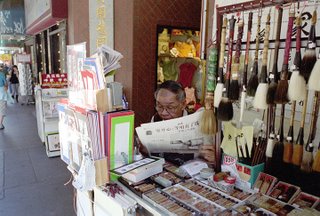Friday, December 29, 2006
Are We Documenting Enough?
Looking to my images and other images online I found that most were lacking as historical records. Some images were so stylized or so personal that they lacked a temporal reference point. The only real reference point was the posting date, or some other point known only to the photographer. Looking at images I could find no way that they would ever date themselves. They seem only to exist now, for now, disposable.
Are we documenting enough? Are we including enough historical information in our photographs? Or, are we making our photographs for the here, the now?
Sunday, November 26, 2006
Holidays on the Dark Side
At the recent family Thanksgiving extravaganza, I took three cameras: A Leica M, a Nikon SLR, and my Nikon DSLR. Because of a recently purchased Nikkor 20/2.8 AF lens, every shot I took was with the Nikons, and primarily with the digital. I'm not a super wide kind of guy, but it was fun shooting the film SLR with the 20 and sticking loved ones on the edges of the frame. On the DSLR the 20mm falls into the 30mm range, so it worked for me as a nice wide—perfect for recording the occassion.
I love my family and friends, but I hate scanning negatives of them, so digital works for me just fine. I had family calling the "day after" asking for the "good" photos from Thanksgiving (all the cell phone and jewelry camera photos had already made the circuit). I sent out several shots, but the film stuff will have to wait until I get them processed and scanned. Here's one that I would hate to spend time scanning:

I'm glad I had the digital for that one. Now I know why us film shooters can have an attitude for being high and mighty. I'd never have taken that shot using a film camera. Film is too precious.
Most of the shots I made on T-day were informal portraits, including the end of the day group shot. Here's a shot using the 20mm on the DSLR:
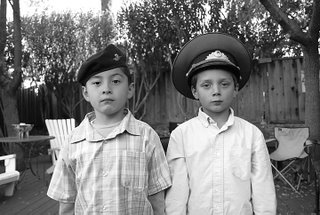
My brother-in-law was a Marine, and he let the boys wear a couple of the hats that he has acquired over the years in the service.
Friday, October 20, 2006
The Photo Essay
Whilst bumbling around on Flickr, I stumbled upon a local photographer who back in the late 1970's shot some wonderful images of a special place in San Francisco. Do yourself a favor and check out Xtoid (Tony) on Flickr. Here's a direct link to his Post Manilatown Archive 1978-1980 set. I'll leave it at that and let his words and images do the rest. If you do visit give him an "atta-boy" for capturing something special.
Monday, October 09, 2006
Single Lens Reflex Camera
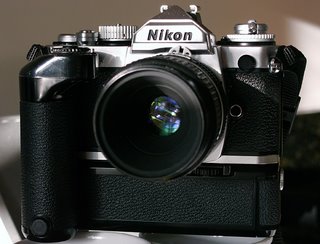
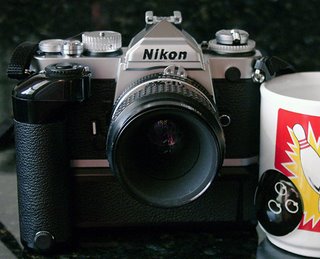
It's a Nikom FM3A with an MD-12 motor drive. I use a 80-200mm, but the lens pictured here is the 55/2.8 Micro. Clean, huh? I also have a couple of Canons (AE-1 & AE-P) and a Nikon 2002, but the FM3A is my SLR baby right now.
Good deals can be had on SLR's these days. These beauties are being shoveled off for dirt cheap. Everyone is fearing that film will disappear overnight and they'll be left holding a useless lump of metal. So they're looking to sell of their metal to buy a lump of plastic. For a quick perusal of some heavy metal SLR's, the cameras that can literally take a beating and keep on clicking, check out RFF's sister site, DSLRexchange, and specifically THIS thread. We're showing off our kits. Note: You may have to join the site to see the thread.
.
Saturday, October 07, 2006
Friday, September 22, 2006
The Clickless Favorite
I was bemoaning with an online photo friend about the curious phenomena of image clicks, and how personal favorites often are the ones that get the least amount of attention. I commented on one of his images and he was surprised. I've a few of those. Here's one:
Color Street
Orange
I like how these two images are tied together by color. Have a great weekend.
Friday, September 08, 2006
Back to Black and White!
I lent my scale out about a month ago (for a week) and was not able to get it back (until this last weekend). So, when my backlog of unprocessed b&w film hit 14 rolls, I stopped shooting black and white film and switched to shooting color film. I don’t need the instant gratification of digital, but I like to see how things are going, especially when I’m working in fairly unfamiliar territory—namely, color. So, by paying for “process-only/no-cut” color negatives from a couple of trusted one-hour labs I was able to satiate my need to see—without feeling the decadence of digital. I am still shooting film after all.
I’ve shot with color, but not to the extent that I have with b&w. There is a big difference between the two, and not the most obvious one, either. For one thing exposure latitude is different. Knowing how to handle the f-stop ring when shooting with color takes a little getting used to. Color balance is tricky too, especially when over or under-exposing.
Shooting with color opens up a lot of possibilities and can be very flexible. You can make excellent b&w images from color negatives, especially if you’re somewhat proficient in Photoshop.
Shooting in color is a different mindset, entirely. Wayne a fellow RFF’er defined the differences between shooting color and shooting b&w (Here in this thread) as:
"I use color film if I want to show you something and I use B&W film if I want to tell you something"
I can subscribe to this, somewhat. It's an interesting and catchy distinction. When I load color film I don't make this distinction, consciously. When viewing color images I don't necessarily feel this distinction, either. But it's interesting, nonetheless, and worth thinking about.
When I shoot color, I find that I look for that extra plane, or level (color), when composing, or seeking out shots.
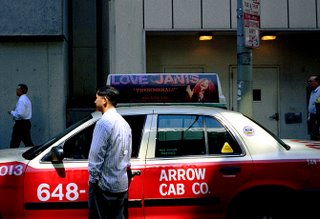
However, with Photoshop (as with most other image editing programs) knowing that I can "go to b&w" gives me the ability to shoot with color film and think in black and white, too.
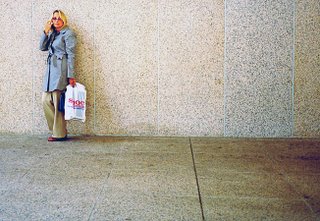

However, while shooting color is pretty flexible, there's no subtitute for the real thing. It's nice to be back shooting with black and white film.
Wednesday, September 06, 2006
I wish I was in Tijuana...
Fondlers and Artists Unite!
RFF took a beating for its response to the Street Photography for the Purist and rightfully so. There really was no reason to disrespect the effort behind the PDF . Some of the photographers/writers included in it are also members of RFF, and the work, and spirit behind the work, is impossible to fault. It’s too easy to discount effort while sitting back doing nothing. RFF can get smug at times, but certainly that’s no reason to snub the site. There are some really good people over there and what is offered is valuable to all photographers, especially those shooting street photography. After all, this is a site dedicated rangefinders, the camera responsible for defining the genre. It's a great place to learn about RF gear, and come up to speed on what works best for street-shooting. I’ve yet to see a question regarding rangefinders go unanswered on RFF. In the end, we use gear, talking about it ain’t a bad thing. It ain’t the only thing, I know.
A strong contingent exists within RFF that wants to pull it away from being such a heavily-weighted gear site, and that effort is paying off. While there’s actually value in knowing information like:
- the Hexar AF is a great street camera, but its fastest speed is 1/250
- the CV 35/2.5 is a great street lens (small, compact and sharp), but it’s contrasty
- fish-scale bokeh can ruin a shot
- the Leica viewfinder is nice, but the Zeiss Ikon might be better
- etc., etc. etc.
in the end people want to see how all this translates into images. And who can blame them. RFF has got its fondlers, but it also has its “artists,” and people who want to see images. That’s why W/NW threads are seemingly always on the front page, and why critique threads started up. The gallery has a strong set of proponents and an equally strong set of consistent posters. Comments in the gallery are way up, and the Photos of the Week thread was recently revived—it appears every Monday. People are shooting street and posting in the gallery. There’s some excellent work. Check out:
J Borger, Kbg32, Graksi, foolproof, benilam,…to name a very few. There's also a nice little RFF splinter group on Flickr
Enough…it’s lunchtime here in the City by the Bay, and I’m going out shooting.
Thursday, August 31, 2006
The Power of the Hip, part II
The direct approach entails seeing a moment, approaching it, intruding to make the photo and moving on. Photos made using the direct approach usually consist of images in which the subject(s) is looking directly into the camera, or where the subjects are obviously fully aware of the presence of the photographer. These are often very engaging images, because often we (the viewer) are looking into the eyes of the subject; we feel a part of the moment.
Photos made using the indirect approach, on the other hand, generally lack the engagement between subject and viewer. As viewers we feel we are looking in on the scene, almost as if we are invisible. There is sometimes a level of detachment, a sense of inaccessibility for the viewer, but that’s not necessarily a bad thing, nor is it always the case.
Both approaches are valid and the line between the two can be blurry, but I think the main point to consider as a photographer is how to confront the moment. Not every moment requires intervention by the photographer, some do, but some don’t. In either case the hip shot becomes a very valuable tool. A photographer skilled at using the hip shot can get very close to a scene and shoot without being detected, without interrupting the moment. Not being detected can mean getting off several shots, if need be, without (or before) being detected. It can mean capturing the truest or purest sense of the moment as it occurs, or working the scene to get a unique or descriptive angle. Something happens when the presence of a camera is detected, people change, situations change, so using the hip shot can mean getting closer to the moment and possibly capturing a truer sense of the moment.
This doesn’t mean that the hip shot is only useful with the indirect approach. It can be very useful with the direct approach, particularly if you’re using an SLR or rangefinder camera. With these types of cameras it can be useful as a means of keeping the camera away from the front of your face, which is off-putting to some people. Remember, that my definition of hip shot is any shot in which the photographer made the exposure without the camera at his or her face, without looking through the viewfinder. The first shot above of the Chinatown busker is a hip shot. The gentleman was seated playing his instrument. This fellow saw the camera and just stared into it.
To use the hip shot effectively means you have to know your gear. You have to know the coverage of the lens. You have to preset focus. You have to judge distances, judge exposure, etc. You have to be skilled at shooting, framing, and composing without looking through the viewfinder.
One of the toughest things about using the hip shot is making images that don’t look like hip shots, and that’s really the key. Your image shouldn’t scream “This a hip shot!” A big part of that is keeping the camera somewhat level. There are a lot of techniques and tools you can use, including using your camera’s strap (shoulder straps are great), and different parts of your body to keep the camera level. Experimentation and lots of shooting are really the only ways to build proficiency.
The hipshot is a technique that can allow you to capture the sense of a moment. It’s possible that when using the hip shot you may be able to capture a truer sense of the moment, because it allows you to shoot undetected. Regardless of the philosophy behind the hip shot, it is a useful technique that requires practice and experimentation. If you shoot on the street, the hip shot is a worthwhile technique to learn, a tool worth having.
Monday, August 28, 2006
The Power of the Hip
As a proponent of the hip shot, I was amazed when “discussion” on RFF sprang up around the technique, and it was proclaimed to be “cowardly.” I was surprised to see this statement receive support. I defended the technique, and will continue to defend it as a valuable tool that all photographers should be comfortable and adept at employing.
I think the main reason that some consider the hip shot to be cowardly is the impression that it is sneaky. The below-the-belt connotation seems to imply that the photographer is shy, tentative and unwilling. Unassertiveness is considered unattractive and weak. Whereas a shy, tentative photographer may be unwilling to confront a subject directly, and may employ the hipshot to “get the picture,” it isn’t a cowardly act at all—even in this context. After all, anybody who actually goes out and takes pictures of complete strangers is not a coward. You have to have some guts to get out there and even try it. It’s hard to do and in this sense using the hip shot is a great way for the beginner to build confidence (and for the seasoned street shooter to get warmed-up). For the beginning street shooter it can be a developmental technique, an aid that can assist in overcoming the fear of photographing strangers, and becoming a better photographer. However, whereas we can consider the hip shot to be a good technique for the beginner there is more to the hipshot than this “training wheel” approach to street shooting.
As a technique the hip shot can be a powerful tool that can open-up an entirely different approach to photography, one that allows the photographer to add a different dimension to their shooting and one that differs radically from the more traditional approach.
To Be Continued
Saturday, August 26, 2006
Some Recent Work
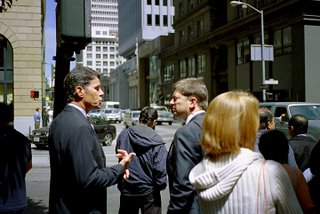
.

.

All three shots were made with a M4-P and a Cosina Voigtlander 35/2.5 lens.
Tuesday, August 15, 2006
Shot in the Back
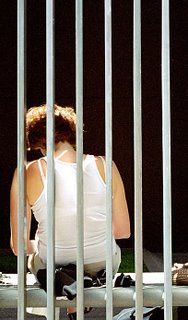
I find it all pretty ridiculous. I haven't shot much on the street with anything greater than a 50mm lens, but if I need to, or want to, no rule is going to prevent me from doing so. Likewise, no rule will prevent me from shooting a subject from behind. I really like the feeling of such images. True these images are far less engaging—in the sense that nothing quite grabs a viewer's attention as much as an image with the subject staring directly back. However the quality of an image in which the subject is shot from behind is unique. There is a detachment, or a detached quality. The detachment seems to strip a layer of understanding from the viewing equation, forcing the viewer to derive meaning from the subject's surroundings. It's an odd phenomena. Without a human face, but with a human form, we seem to search for meaning, deriving it from whatever we can.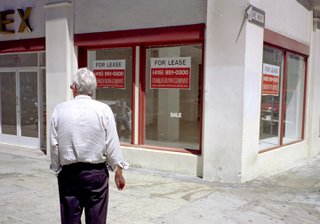
The first photograph that I can recall that distinctly and prominently featured a subject shot from behind, and the one that made a huge impact on me was an image created by Lisette Model. The photograph was of a large man, in a tight fitting t-shirt with thin horizontal stripes (sorry, I can't find this image online right now). The man wears a beret, and he is sitting on a bench. The subject fills about 80-90% of the frame . It is very simply an image of a large man shot from behind. It's an image I'll never forget having seen, yet I still don't know why it has had such an impact on me. Many photographers such as Joel Meyerowitz and Daido Moriyama have used this "technique," to create very memorable images, as well.
Damn the "rules"! Break the "rules"! Make your images.
Thursday, August 10, 2006
Critiques on RFF & Japanese Photographers
I've been shooting, primarily with my M4-P and the CV 35/2.5. I have 15 rolls of b&w in the processing queue, and about 3 rolls of color. I won't have the b&w processed for at least a couple of weeks, but the color I hope to have ready to scan by tomorrow evening.
I've found myself exploring Japanese photographers. A recent visit to the San Francisco MOMA resulted in a ~$80 purchase of two books. Daido Moriyama's Stray Dog, and Nobuyoshi Araki's Subway Love. I also broke free during lunch today to see the Shomei Tomatsu's Skin of a Nation exhibit at the SF MOMA. I was very impressed with the show. So, I'm getting a pretty good education on some established Japanese photographers, who I had very little familiarity with. If any of you would care to recommend others, please drop me a comment, or an e-mail.
As much as I love the Moriyama book, it's the Araki book that has me curious. I can't help comparing Subway Love to Walker Evan's Many Are Called. It's a fun comparison of basically the same project. Both books deal with photographing unaware subway riders over an extended period of time.
The Evans' book is a careful study, the result of ideology and thought. From all reports Evans' culled the best images based on exposure, and framing, cropping them for presentation. Araki on the other hand is much different. First of all, he gives you EVERYTHING, every shot regardless of how well it presents. It's a wild presentation full of blurred images, under-exposed and over-exposed shots, contact sheets, sprocket holes, etc. It's an expressionistic portrayal of life on the subway. It may be driven by an ideology as serious a Evans', but the end result looks much different.
I don't know the plans for the Tomatsu show after it leaves the SF MOMA after Sunday August 13. If it comes to your city check it out. The SF MOMA has a book that accompanies the show. I may end up getting the book, but viewing it at the MOMA, immediately after the show, I was unimpressed. His images are so stunning that the layout of the book and image quality paled in comparison.
I hope to have some images by the weekend, so check back if you get a chance. I hope you're enjoying the summer, if you're in the northern hemisphere, and the winter if your south of the equator.
.
Saturday, July 08, 2006
Point & Shoot Summer
Two views of a remodel of an old supermarket:

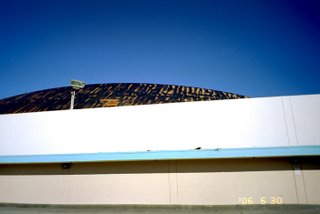
Fuji Natura S; Kodak 400 UC
Wednesday, June 28, 2006
The Penultimate Street Shooter?
I’ve been shooting with the Hexar AF for about 2-3 weeks, and I think that I’ve been able to get a pretty good feel for the camera. Although it has some minor aggravations, the Hexar AF is an exceptional street-shooting camera. It’s discrete, easy to use, has a great lens, with an accurate light meter, and a quick auto-focus. Above all else, it is a "real" camera, with that "real" camera feel. A worthy tool, worthy of consideration by someone who considers himself (or herself) a photographer.
The Hexar AF
My version is the early black model, so it has the “stealth,” silent, or more precisely, low-volume mode. This was the feature (along with the black finish) that led me on to wanting to shoot with the camera; stealth is a desirable quality for me. The silent mode isn’t exactly silent. You can hear the camera’s AF and film advance, if you listen carefully and closely, in a quiet location. Outdoors, and on the street, where the natural din is always present, it’s virtually a silent, black camera, and therefore, stealthy.

As I mentioned, the camera has both auto-focus (AF), and auto film-advance. Neither feature was a selling point for me, because they both pushed the camera toward the dreaded point-and-shoot category. I love cameras that are manually operated. My acceptable limit for automation is an internal meter and auto-exposure capabilities; both of these features are present on the Hexar AF, by the way. The thought of shooting with the AF and auto film advance initially offended my sensibilities. However, I came to appreciate both features as very nice additions for shooting on the street.
Here’s what’s sweet about the Hexar AF
Silent Mode
This is just plain cool; but why? Does it make a difference, on the street, where the din can conceivably drown out the sound of the loudest of cameras? Yes, it does make a difference. I’ve been carrying with me, along with the Hexar AF, a Fuji Natura S, which is a true p&s that is about half the size of the Hexar. It is easily twice as noisy, and there is no way I could have taken shots such as this one with the Fuji and not made a spectacle of myself.

Turning the Fuji on would have been like ringing a bell on this train. Auto-everything cameras have a very distinctive sound. I booted up the Fuji while standing on a quiet train station platform, and people as far away as 40 feet heard the noise and looked my way. I booted the Hexar AF into low-noise mode, at the exact same location, just prior to turning on the Fuji, and not a single person noticed. On the street, even with the din, this can mean the difference between taking one or more additional shots of a scene, as opposed to just getting a single shot off. I’m sure my tank-like Leica M4-P, with its cloth shutter, is just as silent, if not quieter, so why not just shoot with it?
For me the answer is simply a matter of the convenience of size, as well as the quality of the compromises the Hexar brings to the table. I’ve been shooting while on lunch breaks at work. I take the Hexar with me to work on the train in my soft briefcase.

I wear a thin wind-breaker jacket, and when I need it to, the camera fits easily into the jacket’s side pocket. Additionally, the camera offers an excellent compromise between the quality of my M4-P and the array of lenses I own. The lens is no slouch, which brings me to…
Lens 35/2 w/a Built-in Hood
With the Hexar I get a sharp high-quality fixed 35/2 lens, with a built-in lens shade. The 35mm focal length is excellent for shooting on the street.

From what I’ve been seeing the lens is easily on par with my Cosina Voigtlander 35/2.5 lens, but probably not as contrasty as that lens. It’s a different signature that my capabilities can’t define. I might put it near the CV 35/1.7, but I still need some time with the camera to make those kinds of direct detailed comparisons.
Auto-Focus/Auto Film Advance
Without a doubt, auto-focus and auto film advance increase shooting speed. Pulling rapid hip, or quick-shots is no problem.

The Hexar also boots quickly, focuses rapidly, and has a long ‘on-time.’ When it does go into sleep mode (after a couple of hours), it reawakens rapidly with a slight probe of the shutter release. With the AF the photographer can hold the focus by maintaining pressure on the shutter release—after the AF locks. That’s a nice intuitive feature.
Manual Exposure Mode/f-stop Dial and Meter
There are three exposure modes on the Hexar: P (program) mode, A (aperture-priority) mode, and M (manual) mode. I rarely used the A mode, and seldom used the P mode. The M mode is a great way to shoot with this camera. The large f-stop dial on top of the camera protrudes just far enough, towards the front of the camera, that moving it while viewing through the camera is very easy. Once you’re use to the direction, adjusting exposure is a breeze. The camera has ‘+’ and ‘-‘ indicators in the viewfinder, as well as a green in-focus dot, 35mm framelines, and a small (almost useless?) sliding focus scale. To obtain correct exposure the photographer must obtain both a ‘+’ and a ‘-‘.
The meter, btw, is excellent, and like the AF the exposure, when in P mode, can be held, so the photographer can obtain a reading from the shadows (for example) and then readjust the framing. When doing this, it’s important to keep in mind that you’re also holding the focus. What I do instead, while in M mode, is assess the light (either visually, with the camera's built-in meter, or with a handheld meter), set the shutter speed, and adjust the f-stop. I’ll use the camera’s meter to take range readings, noting shadow and highlight.

I’ve gotten some excellently exposed negatives using both the P mode and the M mode. The meter is great for taking averaging readings. By pointing the camera at an open scene, and taking a light reading, you can get very accurate readings.
Here’s what is not so sweet about the Hexar AF
Too Quiet?
Can it be that silent mode is too silent? Yes, sometimes. It seems that sometimes silent mode is so effective that occasionally I’ll have to check to make sure I actually took a picture, and the little display window doesn’t easily cooperate with that task, preferring to cycle between the shutter speed (remember, I shoot in M mode) and the frame number. So, there’s always this little delay of about a second or two wherein I have to keep an eye on the little window to verify the frame advance.
Exposure Indicators are Hard to See Outdoors in Bright Light
The ‘+’ and ‘-‘ indicators located at the bottom of the viewfinder can be difficult to see outdoors, and usually are most effective when the camera is pointed toward a dark scene. This can be very frustrating, and puts a damper on using what is an excellent meter.
Top Shutter Speed is only 1/250
This is almost a deal-breaker for me. This is just too way too slow. I like a top speed of at least 1/1000, and I’d love to shoot with the AF’s cousin, the RF, a camera with a top speed of 1/4000.
Small Buttons and Cryptic Menus
The small buttons and cryptic menus are well known “characteristics” of this camera. I’ll only address the fact that adjusting shutter speed, though easy, is much easier on other cameras. Adjusting shutter speeds should not take all your attention to achieve. Like the f-stop dial on this camera, changing shutter speed should something you can do without taking the camera down from your eye. However, with a top speed of 1/250, and shooting on the street, you’ll probably seldom what to change the shutter speed anyway.
Conclusion
The Hexar AF is a joy to use. As a small stealthy street shooter, I doubt it can be beat. While technically a point & shoot, the Hexar when operated in M mode feels like a “real” camera. As someone who categorizes himself as a photographer, I’ve never felt diminished shooting with this camera. A co-worker saw my camera sitting on my desk, and picked it. She knew I was a photographer, and I think she was surprised to see that I possessed a camera that seems to scream, “I’m a point and shoot!” I found myself explaining the advantages and features of the camera to her, not defensively, but out of pure satisfaction and admiration for what is an outstanding camera.
To see more of my Hexar shots, visit my rangefinderforum gallery HERE.
July 13, 2006 Addendum: I was asked why I considered the Hexar the penultimate street shooter, as opposed to the ultimate street shooter. I had to pause as I thought this over. For some of you, it may truly be the ultimate street shooter. I know as I continue to shoot with the camera, I'm beginning to wonder how I would handle some of the compositions I've made (and the ones I'm currently making) using my Leica, which to me is the ultimate street shooting camera. Yet, the Hexar is just so darn fast to use that I find myself shooting without breaking a stride, often just coming to a "California Stop" (a "rolling" stop). If anything the Hexar has educated me on shooting on the street, and challenged my perception on what a street shooting camera should be. I plan on trudging the Leica and a lens to work with me next week, to compare the experiences.
Thursday, June 15, 2006
Building a Backlog of Shots
I got a chance to mix up some developer, so I'll have other more recent images from my outings with the Hexar to post very soon.
Here's a teaser for you: I picked up another point & shoot camera. I'll divulge what that camera is and post some images in another post. I hope you are enjoying the summer. Get out and shoot, shoot shoot.
Friday, June 09, 2006
The Color Coordinated Scene 2

It's not tidy, and it's a little ragged around the edges, but I kind of like that.
Hexanon 35/2, Kodak 400 HD
Thursday, June 01, 2006
Hexar AF Results
I recently acquired a black Hexar AF (with silent mode). I'm just getting the hang of it, and still getting used to using it. I plan on shooting a lot with this camera in the coming months, so I'll be reporting on and reviewing the camera. If you're interested in this camera you can get some great information at CameraQuest's excellent Classic Camera Profile page, and specifically the Hexar AF page.
Wednesday, May 31, 2006
Diane Arbus and a Civil War Re-Enactment
I think it’s important to let your photography be a vehicle for learning, for stretching your range of experience. What is interesting is that if you venture out with an open-mind, into the unfamiliar, the uncomfortable, you will inevitably come away with having learned something, with a new appreciation, or with a different perspective.
This attitude can guide us toward some unforgettable experiences and (hopefully) some wonderful photographs. It worked for Diane Arbus. My favorite Diane Arbus quote is from the first line of her famous Aperture monograph:
I've always loved how this quote opens her book, a book of work that is a journey, for both the viewer and the photographer, away from the normal, and out to the fringes. It’s a great attitude for a photographer to have, and one that even the lowest rank of us amateurs can adopt and put to use.
I agreed to go to this re-enactment, primarily because it was a Sunday family trip, and also because the real purpose of the family trip was to ride a train through an old growth redwood forest. The re-enactment was just an OBTW happening ocurring on the grounds of this place called Roaring Camp Railroads. I figured I could make a challenge out of it, by doing something photographically different, but I ended up being surprised.
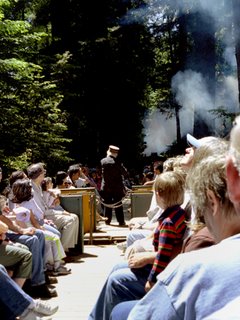
While the train ride was very nice, and a little less than I expected, I have to say that I was very impressed by the re-enactment, particularly the battle scenes (and the canons!). The level of detail and authenticity displayed by the participants also impressed me. They played the part very well, with a consistency that surprised me. For instance this fellow...

...was instructing my daughter on how a man and a woman, back in the 1800's, would hold hands while in public. It was all about showing respect for the woman, and taking care of reputations and appearances. Coincidentally, we later came across this couple:

Now, I swore to myself I wouldn't take pictures like this, but I had to take this one, because a photographer (not me!) was badgering this couple. This photographer had a big ol' DSLR (of course) and was trying to get this fellow to put his arm around the girl and hold her closer to him, but this guy wouldn't do it. He kept saying that his “…father would get mad at him." The photographer wasn't buying it and was getting pushy, but I knew why this guy would not put his arm around the woman. He was playing the part, and there was no way someone was going to catch a picture of him not playing the part. He never did it, and the photographer waved them off and walked away. That level of commitment and dedication to authenticity impressed me. It was something that I found from all of the participants, who actually camped in the park in these little white pup tents. This was serious business to everyone, and that commitment deserved some degree of respect.
All in all it was fun, and I would encourage all of you out there to try to see, not just the photographic potential of a place, or a happening, but also the educational potential and enlightenment (however small) that your photographic pursuits can bring you.
Here are a couple of shots that I'm happy with.
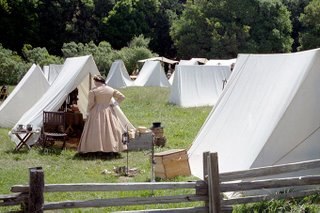

I took two cameras with me. This one, the Konica Hexar AF, had color film (Fuji Superia 200). I’ve several rolls of black and white that once I develop, I’ll post if they’re interesting.
Saturday, May 27, 2006
Tuesday, May 23, 2006
90mm Comparison

The 90mm lens comparison is in. Pictured above is the sheet depicting the lenses stopped down one from wide (f4). For the other two sheets and more details (and responses) click Here to go to the rangefinderforum thread.
The lenses pictured above (click to see image larger), starting from the top left and going clockwise, are Leica 90/2, M-Hexanon 90/2.8, Minolta Rokkor 90/4, Minolta Rokkor 90/4 (again, but at f5.6—one stop down from wide) and the Cosina Voigtlander 90/3.5. The film is Tri-X developed in D76 1:1.
Monday, May 22, 2006
90mm
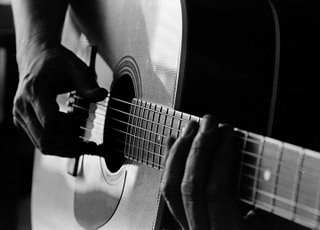
I've been shooting a lot with the 90mm focal length. The 90 isn't the most common/practical length, but I've found that I'm using it more and more. I've primarily been using my 90/2 indoors at my kids' karate classes, as well as to shoot portraits.
This image was shot using a Minolta Rokkor 90/4 and Tri-X film. I catergorize this shot as a portrait.
I shot a 90mm test using my three 90's, and as soon as I'm done processing the film, I'll post it up either here or on RangefinderForum.com. If all goes well, I'll post sometime this week.
Friday, May 19, 2006
The Day the Light Got in the House
 This strange afternoon light made its way onto the wall, reflected off the countertop; it invaded through the kitchen window, and like a bird in a house, maniacal, confused, it found a safe perch, and rested, and waited.
This strange afternoon light made its way onto the wall, reflected off the countertop; it invaded through the kitchen window, and like a bird in a house, maniacal, confused, it found a safe perch, and rested, and waited.
Saturday, May 13, 2006
CaliGirls

I'm appearing a bit like a voyeur here, but actually this was the first shot after a roll change. I looked up after changing the roll, put the camera to my eye, focused and clicked off several exposures. These California girls heading out to the mid-morning surf happened across the frame. This was the first clean exposure. You're looking at Tri-X shot through a CV 35/1.7
Friday, May 12, 2006
The Giant Camera

The Giant Camera is actually a camera obscura, a walk-in pinhole camera and minor tourist attraction. Visitors to the Cliff House will find the Giant Camera ensconced on the lower back deck, close to another minor tourist attraction, Seal Rock. The Giant Camera doesn't fit the decor of the rather modern looking Cliff House retaurant. The camera's design is really almost tacky, but it is loved by San Franciscans.
The experience of being inside the Giant Camera is magical. Several visitors at a time enter the camera through the front doors and find a position around a central viewing area. Once inside a guide closes the doors, and the visitors suddenly find themselves in a very dark, very quiet space. They wait in the for their eyes to adjust to the dark with nothing but the sound of the Pacific and their whispers and giggles.
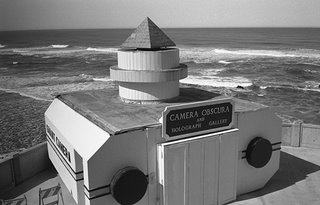 Allowing for the adjustment, the guide then opens the aperture, which is located on the pyramid-shaped structure on top of the camera, and an image of the Pacific Ocean magically appears on a horizontal surface in the middle of the room. The guide can rotate the aperture to provide different views of the ocean, and even Seal Rock.
Allowing for the adjustment, the guide then opens the aperture, which is located on the pyramid-shaped structure on top of the camera, and an image of the Pacific Ocean magically appears on a horizontal surface in the middle of the room. The guide can rotate the aperture to provide different views of the ocean, and even Seal Rock. 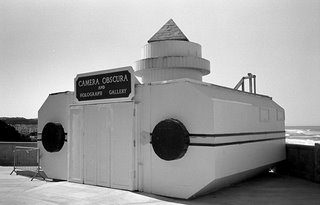
Most tourists and visitors seem underwhelmed by the experience. Afterall, there's a much better and realistic view just outside the door, but for anyone who has ever been remotely serious about photography the Giant Camera is wonderful, pure magic.
Friday, May 05, 2006
Wednesday, May 03, 2006
Mood Light
 Not a very cheery image; I know. The fog will do that. This type of light presents a challenge. It seems to have a built-in mood and seriousness to it.
Not a very cheery image; I know. The fog will do that. This type of light presents a challenge. It seems to have a built-in mood and seriousness to it.Tuesday, May 02, 2006
What's Your Summer Photo Project?
I think projects are a good thing, especially when they are created in response to a concept, or an ideology. I love how Walker Evans' conceived his subway project, the work which eventually became the book, Many Are Called. The project idea arose from a strong ideological reaction to classic studio portraiture. Evans' felt compelled to create the antithesis of the studio protrait, and set about on his masterpiece. IMO, the result was very successful, a beautiful and fascinating body of work. To me this is the absolute best approach for a project. The desire to shoot cohesively should be driven by a greater need.
The wrong approach is one wherein the photographer seeks to handicap himself as a means of improving his "skill." Such projects usually entail the photographic equivalent to walking around for three days with your right leg tied back, in the hopes of improving the strength of your left leg. For instance, shooting strictly with a particular focal length, shooting only images within a one block radius of your front door, shooting only things that are the color red, are all handicap-based projects, especially when set about so simply.
For me, a self-imposed project should be an opportunity for discovery, or enlightenment, and it should be something that needs be written down. It doesn't need to be thematically grand, or ideologically driven. It can be driven by emotions and desire, but it should be purposeful and multilayered. For instance, it's one thing to want to photograph the simple beauty and the majesty of an old-growth redwood forest, but to set out to want to explore and convey, along with that beauty, the mysterious and mystical, or a sense of age and time, is taking the project to another level, a level that will challenge the photographer. By adding this additional layer the photographer adds a degree of measurability to the project that will help to determine whether the photographer was successful, or not.
The success of the project is ultimately determined by the viewer, so while a project can be a personal endeavor (and there's nothing wrong with shooting strictly for oneself), the feedback is invaluable, and any serious project should take into account the viewer, or the audience.
I hope to announce the completion of my summer project(s) here, and if anyone else is planning a summer project, and is posting online, and would like someone to view and provide feedback, I'll gladly help out in anyway I can.
Saturday, April 29, 2006
Wednesday, April 26, 2006
Untitled Places
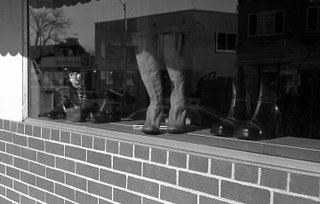
This gallery groups together of all my recent images of places that have intrigued me into taking their picture. I do a lot of shots like this.
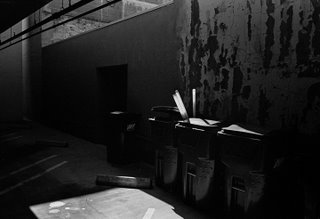
They typically don't get a lot of attention when I post them online, but I don't care. I'm really enjoy them and enjoy seeing them grouped together. It's like they have a cause now, a raison d'etre.





